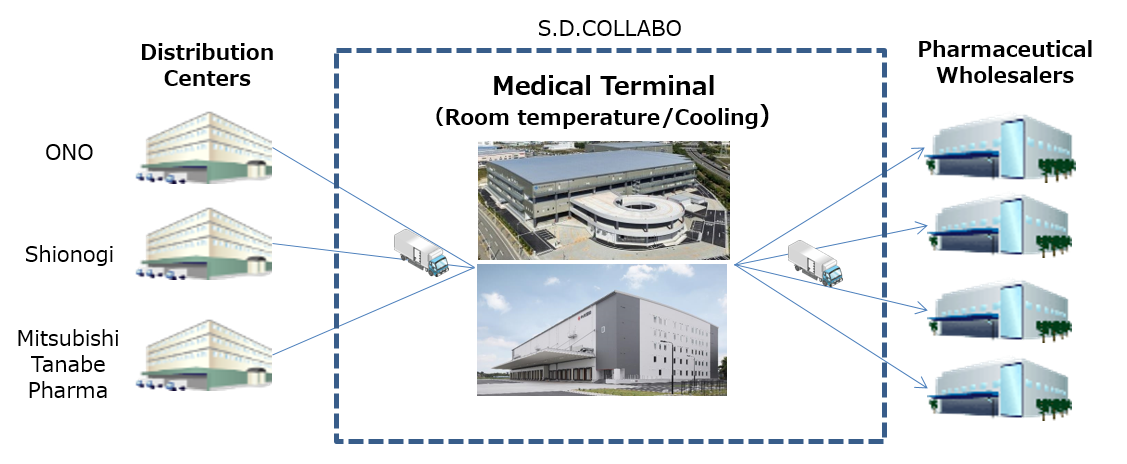Notice concerning the Start of Joint Transportation in the Domestic Distribution of Prescription Pharmaceuticals
- Start of the first joint transportation in the pharmaceutical industry since January 2023, in accordance with the GDP guideline -
Ono Pharmaceutical Co., Ltd. (Head Office: Osaka, Japan; President and CEO: Gyo Sagara; “ONO”) announced that it has started joint transportation initiative since January 2023, together with Mitsubishi Tanabe Pharma Corporation, Shionogi & Co., Ltd., and S.D. COLLABO Co., Ltd., in order to improve the quality assurance of prescription pharmaceutical products and achieve the integrity of the distribution process*1 in domestic logistics.
This initiative is the first joint transportation in the pharmaceutical industry to implement in accordance with the Good Distribution Practice (GDP) guideline*2.
In the environment surrounding pharmaceutical distribution, the GDP guideline issued in December 2018 requires stricter quality assurance and integrity of the distribution process during the transportation and storage processes. Furthermore, in addition to the shortage and aging of drivers, major issues are emerging in stable logistics of pharmaceutical products, such as rising fuel costs and expiration of the grace period for enforcement of Act on the Work Style Reform granted to the logistics industry (some of businesses and operations such as driving vehicles) at the end of March 2024*3. In addition, the reduction of CO2 emissions has become a social challenge as a countermeasure against global warming.
In order to resolve these issues, we will work on efficient joint transportation across the transportation route from the distribution centers of each pharmaceutical company to pharmaceutical wholesalers according to the GDP management standards jointly formulated by the four companies, as follows:
-
We improve quality assurance by carrying out temperature-controlled transportation in all temperature zones.
-
We secure stable supply by increasing the loading efficiency of transportation and reducing the number of vehicles in operation, as well as alleviating shortage of drivers.
-
We also aim to reduce CO2 emissions by reducing the number of vehicles in operation.
ONO will continue working to ensure stable supply of prescription pharmaceutical products and improve quality assurance by jointly pursuing this new initiative for logistics of pharmaceutical products.
Joint Transportation Scheme

-
Integrity of the distribution process
It refers to maintaining the condition of pharmaceutical products which are manufactured based on manufacturing and marketing approval and released to the market, and ensuring the absence of quality deterioration, breakage, destruction, and falsification of pharmaceutical products in the distribution channel. -
The Good Distribution Practice (GDP) guideline
In December 2018, the GDP guideline was officially issued in Japan by the Ministry of Health, Labour and Welfare in the form of "Japanese Guideline to Good Distribution Practice for Medicinal Products." This guideline lays down appropriate tools to assist wholesale distributors and marketing authorization holders in conducting their activities, and compliance with this guideline will ensure control of the distribution chain and consequently maintain the quality and the integrity of the medicinal products. This guideline also lays down the appropriate tools to prevent falsified medicines from entering the legal supply chain. -
The year 2024 logistics problem
Act on the Work Style Reform was promulgated in 2018 and came into effect from 2019. However, it exempts regulation on some of businesses and operations, such as driving vehicles, until the end of March 2024, and will come into effect in April 2024. Above all, there is a concern that the "upper limit on overtime work" would shorten possible driving distance of each driver, making long-distance transportation more difficult. In addition, there are concerns over decrease in sales in the trucking industry, decrease in income of truck drivers, and increase in freight rates for shippers, all of which are referred to as the “Year 2024 logistics problem.”
